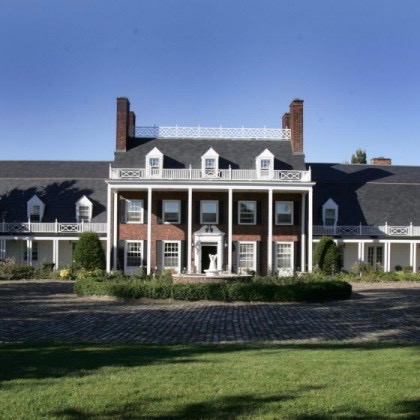"While most Clevelanders have never heard of the architect Philip Small, it is very likely that they have seen his work around town. In the 1920s, Small and his associate Charles Rowley became favorites of the Van Sweringen brothers, who commissioned them to design Shaker Square, the interior of the Higbee's department store on Public Square (now the site of the Horseshoe Casino), and the brothers' own Daisy Hill estate in Hunting Valley, to name a few. Separate from his work with the Vans, Small also designed nearby John Carroll University, the Cleveland Playhouse, the Karamu House, and a number of buildings on the Case Western Reserve University campus.
The Van Sweringens also entrusted Small and Rowley with the task of designing one of the four clusters of Demonstration Homes in Shaker Heights. Built early on in Shaker Heights's history, the Demonstration Homes provided potential home owners with examples of the high-quality type of home that could be found in the exclusive suburb. Indeed, the homes were a symbol of the dignified, up-scale community that the Van Sweringen Company desired to create, and they provided the foundation from which the city grew. The houses were designated as Shaker Heights Landmarks on June 27, 1983.
Small's five demonstration homes, built in 1924, lie along South Woodland Boulevard, just west of Warrensville Center Road at (from east to west) 20000 South Woodland, 19910 South Woodland, 19700 South Woodland, and 19600 South Woodland. The fifth is nearby at 3158 Morley Road. All of the houses were designed in various types of English style, are built of brick and stucco with wood shingle roofs, and feature Tudor half-timbering and leaded glass casement windows on their exterior. English architecture was popular during the development of Shaker Heights, and Van Sweringen Company newspaper advertisements from the 1920s favorably compared Shaker's ambience with the "charm of England." A 1926 ad even refers to Small's Demonstration Home at 19910 South Woodland Road as "a true modernization of the famous old country houses of Dickens' England." At this time, the idealized English countryside served as a symbol of peacefulness, beauty, and security to wealthy Clevelanders looking to escape an increasingly chaotic big city. Indeed, as the same 1926 ad asks, why "go to England, thousands of miles away, to visit that charm" when "we can live with it always in Shaker Village, thirty minutes away[?]"
Philip Small's masterfully designed Demonstration Homes helped further this conception of the English countryside in northeast Ohio, contributing to Shaker Heights' ultimate success. It is little wonder, then, that the Van Sweringens continued to turn to Small for the design of some of their most important construction projects."
-Michael Rotman
Source: Cleveland Historical


No Comments Yet, Leave Yours!